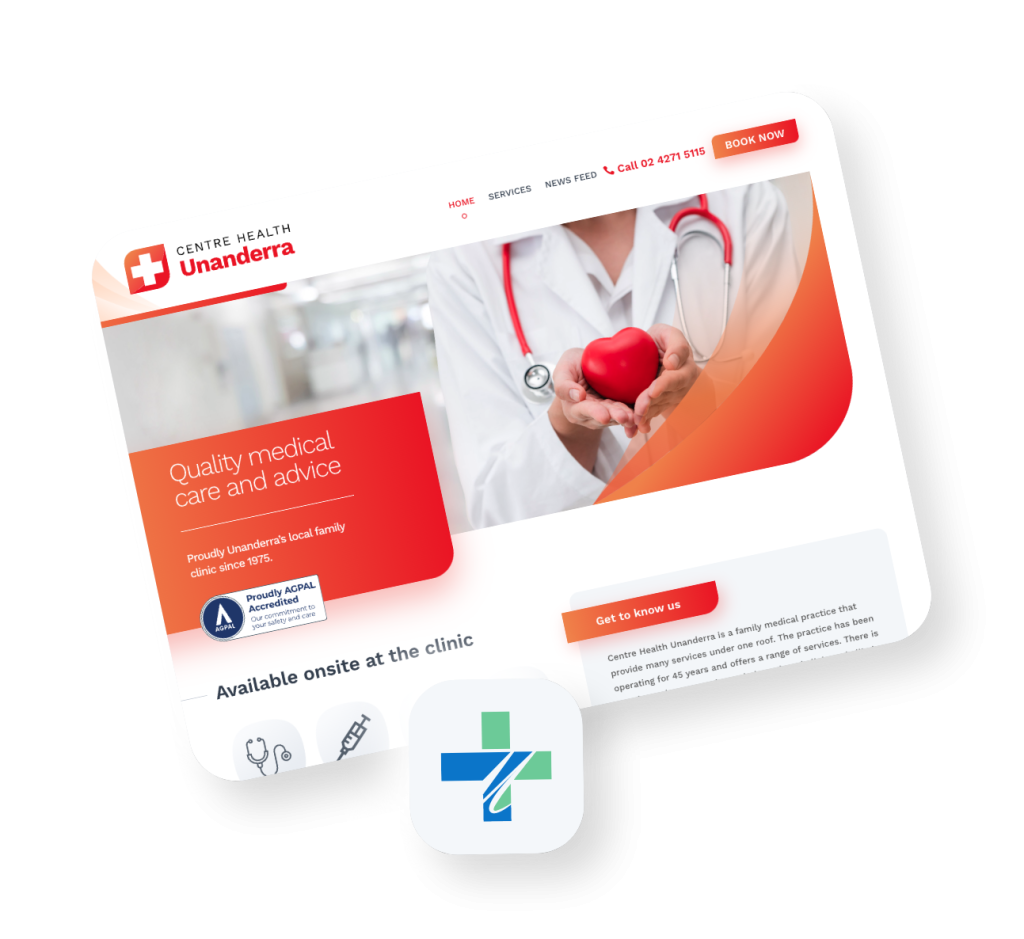6 TIPS FOR
Building a
Great Medical Website
If you’ve been wondering how to make a great website, you’ve come to the right place. Whether you’re a dentist, physio, optometrist, cardiologist or general practitioner, having a professional website is a must.
But where to begin?
Well it’s your lucky day, because our experts in medical website design and development created a guideline taking you through step by step of how to make a great website.
Read on to discover 6 simple and easy-to-implement tips on how to create an amazing website.
Why is medical marketing so important?

You can provide the highest quality care or offer the most special services, but without patients knowing about it, you don’t have a business.
Medical centres and specialist practices need marketing just like any other business.
And with patients these days wanting more transparency than ever before, you need to be able to communicate any practice changes or updates quickly. Otherwise, you risk losing them to your competition.
Your website is one of the easiest ways to do that.
That’s right, a medical website is one of the most cost-effective communication tools for healthcare professionals. Any changes to your practice can easily be communicated to all of your patients — with one click alone!
For example, if you have a new doctor that just joined your team or you have an exciting new medical treatment to offer. These additions can simply be announced on your website, saving you time and money trying to tell patients individually.
And if you have a well configured website, it can even help bring you in more patients and fill more booking slots. Making your practice more profitable…
But first things first.
Benefits of healthcare marketing
 A website is a fantastic way to promote your practice to the local community and keep current patients updated.
A website is a fantastic way to promote your practice to the local community and keep current patients updated.
But a website is more than just an amazing communication tool.
A well designed, technically sound website builds the foundation for any additional digital marketing success. Think about improving practice-patient relationships, reducing administration time and staff costs, getting more high-paying clients…
It’s all possible with a well built website.
Some more benefits of a great website:
- Builds trust and reputation
- Improves communication
- Reduces operational costs
- Optimises client return
- Helps increase patient list
- Increases client retention rate
Want all that? As promised, we will now show you how you can make your website the best it can be.
Whether you already have a website or are looking to make one, here are our top 6 tips for creating a great medical website.
1. Highlight nature of practice
 As every practice is unique in its own way, this must be clearly communicated to your potential new patients.
As every practice is unique in its own way, this must be clearly communicated to your potential new patients.
Are you a dentist specialising in crown fillings? Do you offer family-focused medical services? Is your practice known for its exceptional customer service? Are you AGPAL accredited?
These are the sorts of questions to consider when we talk about highlighting the nature of your practice. Usually, there are two important things to cover when doing this.
- Type of practice + services
- Points of differences
First, it is crucial that your website visitors immediately understand the type of practice you are and what services you offer. We recommend a concise practice description on the Homepage and a seperate landing page dedicated to your service offerings. Don’t forget to feature the services you are specialised in or most known for!
Second, when writing your practice description make sure to highlight your points of differences. Do you have the best ever waiting room? Perhaps you earned an award in the field of your discipline? Or maybe deliver the most exceptional customer service?
Be proud of what you’ve accomplished and don’t be shy to show this. This is how you are going to stand out from the practice next door.
2. Consistent, responsive design
 Your website is the digital face of your practice, so maintaining visual and verbal consistency is important to provide a cohesive brand image.
Your website is the digital face of your practice, so maintaining visual and verbal consistency is important to provide a cohesive brand image.
Why does that matter so much?
A cohesive brand image helps you build trust, credibility and loyalty. So if you want clients to return to your clinic over and over again, brand cohesiveness is crucial.
So, if you have brand guidelines in place, great! Follow them when creating your website to ensure all visual and verbal elements are consistent.
If you don’t have any brand guidelines, just make sure you choose a colour scheme and tone of voice that represents the nature of your practice. And stick with it!
Another important matter is to make your design responsive. What do we mean by that?
A responsive design is one that works on all types of devices. For example, a mobile phone, desktop or tablet.
Remember, your website is a communication tool. On one hand it needs to look appealing and consistent, but on the other hand it needs to function.
A responsive website ensures that website users can enjoy a seamless user experience no matter how they interact with your practice.
3. Easy navigation
 Furthermore, to ensure a seamless user experience, easy-to-use navigation is a must. Because there is nothing worse than going on a website and feeling overwhelmed not even knowing where to find things!
Furthermore, to ensure a seamless user experience, easy-to-use navigation is a must. Because there is nothing worse than going on a website and feeling overwhelmed not even knowing where to find things!
When it comes to your site navigation, less is more. Your menu should be kept simple and short, only reflecting the key landing pages you want to send traffic to. For example, key landing pages for healthcare providers should consist of services, fees, team, and about the practice.
Do you need a blog?
Although it’s not necessary, it can provide huge value to your current clients and increase the visibility of your practice to new potential clients. Especially if you’re a specialist practitioner or offer complex services, a blog is a great way to break things down and provide more information.
4. Relevant content
 As just touched on, your website should provide information on the services, fees, team and history of your practice. At the same time, the way you structure your content is super important to get your site to appear on search engines.
As just touched on, your website should provide information on the services, fees, team and history of your practice. At the same time, the way you structure your content is super important to get your site to appear on search engines.
But we’ll come to that in a minute.
First of all, every landing page needs to have a clear purpose and be able to catch, maintain, and keep a user’s attention. Let’s have a look at the homepage of a website we previously designed and developed for one of our clients.
Source: Centre Health Unanderra
As you can see, the content is clearly organised with headlines, banners, images and lists, making it easy to follow. The design is consistent and it’s immediately clear what type of practice this is.
Now, let’s see how you can get your website to rank higher on search engines.
5. Search Engine Optimisation (SEO)
 If you want your practice name to appear at the top of search engine results, your site needs to be search engine optimised.
If you want your practice name to appear at the top of search engine results, your site needs to be search engine optimised.
Without getting too technical, search engines like Google will always prefer websites with the most relevant content. For example, if someone is looking for “dental clean costs” and your website can provide that information, you’re already a step ahead of your competition.
Whether it’s SEO for dentists or any other medical practitioner, here are the most important components to consider to improve your SEO:
- Keywords – include relevant keywords and keyphrases throughout your content. After a quick keyword analysis for dentists we found relevant keywords to be dental clinic, orthodontists, periodontist, emergency dentist, dental crown, and gentle dentists
- Internal linking – connect one landing page on your website to another on your website. It improves the user experience and helps keeping your bounce rate low
- Page speed – Search engines prefer fast websites. Conduct a website speed test if you’re unsure of your website speed
- Security – Secure websites are always ranked higher than non-secure websites. Make sure your site has an SSL certificate and is PCI DSS compliant
- Mobile-first index – Google’s algorithm prefers mobile-friendly sites. As previously mentioned, a responsive design is important
Optimising your website for search engines can be a bit of a pain, but SEO is crucial to your site performance and therefore, practice success.
If you’re unsure about SEO for your practice, get in touch with our SEO team!
We’ve helped doctors, dentists, optometrists, pharmacists, physios, and many more healthcare professionals to rank higher on Google.
Book an obligation-free consultation and we will have a look at your website, highlighting pages for improvement and how you can increase visibility.
6. Clear conversion paths
 Last but not least, your medical website needs clear call-to-actions. These are short sentences of no more than 3-4 words prompting users to take a specific action.
Last but not least, your medical website needs clear call-to-actions. These are short sentences of no more than 3-4 words prompting users to take a specific action.
For example, if you offer online bookings (we highly recommend you do!) you should have a button clearly stating to book online. It could be something along the lines of “Book Appointment” or “Make Online Appointment”. Or if you prefer for clients to make appointments via the phone you could display a button saying “Call Now”.
Call-to-action buttons should also be clearly visible. Use bright colours that stand out from the background, but make sure they are consistent with your brand!
The Final Verdict
Websites are a must for any healthcare professional. It’s one of the most cost-effective communication tools and provides the perfect foundation for additional marketing efforts for ultimate practice success.
Sounds like something you want, but don’t have the time? Or maybe you still have questions?
Chat to our friendly team today and let’s see how you can get a website that brings your practice On Point!